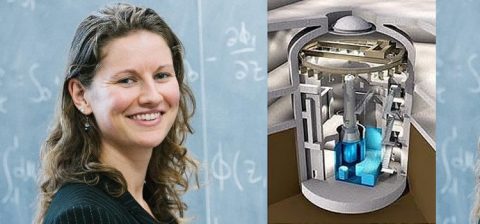
‘Tomorrow’s nuclear reactors are closer than you think’
7 maart 2016 – De Amerikaanse energiesite Breaking Energy staat stil bij de ontwikkelingen in kernenergie. ‘Tomorrow’s nuclear reactors are closer than you think.’ Aangemoedigd door het Department of Energy is een nieuwe generatie wetenschappers aan de slag. Professor Rachel Slaybaugh: ‘Students chose nuclear because they want to save the world’.
Uit het bericht van Breaking Energy
‘(…) A new generation of innovators is pioneering the future of nuclear energy in partnership with our National Labs. Citizens and policymakers leading the global transition to a low-carbon economy are focusing efforts on developing — and building — advanced nuclear reactors. To support these efforts, the Department of Energy is working to forge key partnerships and support a culture of nuclear innovation driven by this new generation of scientists, university researchers, entrepreneurs and investors. The current nuclear reactor fleet is the low-carbon workhorse of the electricity world. In 2014, nuclear power generated about 60 percent of the carbon-free electricity in the United States. Today’s light-water reactor designs provide a safe, effective and affordable bridge to new nuclear reactor technologies — promising increased flexibility and the ability to match electricity generation with demand.
First across that bridge may be small modular reactors (SMRs), which vary in size from 50 to 300 megawatts (about one-fourth the size of current reactors). With lower initial capital investments and shorter construction timelines than traditional-sized reactors, SMRs are progressing toward commercialization. They could replace aging, carbon-emitting coal power plants, and their smaller size provides more flexibility in where they can be located.
Tomorrow’s fission reactors will broaden our energy options by using innovative fuels and, potentially, alternative coolants such as high-temperature gas and liquid metal or molten salt instead of water. Since many advanced reactor designs operate at a higher temperature than light-water reactors, they are ideally suited to replace fossil fuels for industrial applications that require high temperature process heat (such as oil refining and biofuel production) with nuclear-generated heat at an enormous savings in carbon emissions.
Nuclear innovation doesn’t stop at fission. Companies large and small, along with labs such as Princeton Plasma Physics Laboratory are studying nuclear fusion — the energy source of the sun and stars — in the hopes of someday harnessing fusion for power on Earth. (…)
University of California-Berkeley professor Rachel Slaybaugh summed up the buzz around nuclear technology innovation during a recent roundtable on advanced nuclear power: “Now is an exciting time to be in nuclear energy,” she said. “Nobody told today’s students that nuclear innovation is supposed to be slow. They chose nuclear because they want to save the world. Defining how the universities facilitate collaboration between students and industry will be key to our success.” (…)’
Bronnen
Breaking Energy, 3 maart 2016: Tomorrow’s Nuclear Reactors Are Closer Than You Think
Foto: professor Rachel Slaybaugh (foto: University of California-Berkeley)



